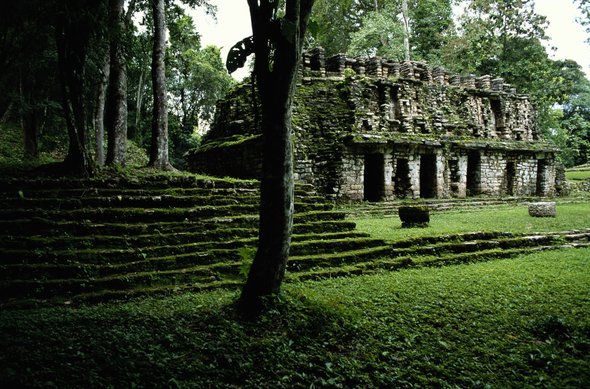(单词翻译:单击)
听力文本
This is Scientific American — 60-Second Science. I'm Christopher Intagliata.
If there's a fifth Indiana Jones movie, Indy might want to use one of the hottest new tools revolutionizing archaeology: LiDAR, or Light Detection and Ranging, which allows archaeologists to survey ancient sites from the skies.
"Think of an impressionistic painting, the closer you look at the painting, you see the brush strokes. When you pull away, suddenly it's obviously the face of a woman in a park or something. Your brain can in sort of interpolate that stuff better at a certain distance."
Marcello Canuto, an archaeologist at Tulane University.
"LiDAR allows us to see these small little features that close up look like little pieces of data that we're not sure what to do with, but when you zoom out, there it is, clear as day."
The technology works like radar, but shoots laser pulses instead of radio waves, to 3-D map a landscape. In 2016 it was used to map over 800 square miles of Guatemalan jungle, including the area around the famous tourist site Tikal. Canuto remembers when he and his colleagues first saw the footage.
"One hour went into two, went into three. We just lost track of time. It got dark outside, we were just open mouthed, we couldn't believe what we could be seeing."

What they discovered, after careful analysis, were buildings in areas they'd already excavated. And big landscape-level features, like canals and roads, bridges, ditches and walls.
"It was a very humbling moment for all of us. You know, to be able to think, wow, that was under our feet the whole time and we really didn't recognize it." Overall, the density of structures suggests a population of somewhere between seven and 11 million people in the region, more than 1000 years ago — which aligns with previous estimates.
Maps, photos and a catalog of what they found are in the journal Science.
Nearly 100 years ago, the famous aviators Anne and Charles Lindbergh flew over some of the same swaths of jungle, taking photographs from the sky, partly in hopes of aiding archaeologists. "It was very early appreciated that under the jungle canopy there was a lot to see. But if we could only see through the jungle canopy." Now, we can. And it's a foundation, Canuto says, for an entirely new era in archaeology.
Thanks for listening for Scientific American — 60-Second Science. I'm Christopher Intagliata.
参考译文
这里是科学美国人——60秒科学。我是克里斯托弗·因塔利亚塔。
如果《夺宝奇兵》出第五部,印第安纳·琼斯可能会想使用一种最热门且彻底改革了考古学的新型工具:激光探测与测量(简称LiDAR),这一工具可让考古学家从空中考察古代遗址。
“想象一下印象派油画,你近看这幅画时,会看清该画的笔触。当你拉远看时,会突然发现这是一名女性的脸,她正在公园之类的地方。在稍远的距离,你的大脑可以更好地插补内容。”
杜兰大学的考古学家马塞洛·卡努托说到。
“激光雷达让我们能看见这些细小的特征,这些特征近看起来就像小数据,我们不知道该如何处理,但当你远看后会发现,原来如此,一清二楚。”
这项技术的工作原理类似于雷达,但激光雷达发射激光脉冲而不是无线电波,以此来绘制3D地图。2016年,该技术曾被用来绘制800多平方英里的危地马拉丛林地图,包括著名旅游景点蒂卡尔周围的地区。卡努托记得他和同事首次看到这段素材时的情形。
“一个小时过去了,两个小时过去了,三个小时过去了。我们忘记了时间。外面天已经黑了,而我们只是惊讶地张着嘴,简直不敢相信我们看到的东西。”
经过仔细分析,他们发现那是他们已挖掘地区中的建筑物。还有大型景观级特征,比如运河、道路、桥梁、沟渠和围墙等。
“对我们所有人来说,这是一个令人非常羞愧的时刻。我们会想,天哪,这些一直在我们脚下,可我们竟然没认出来。”总体来说,建筑物的密度表明该地区1000多年前的人口大约在700万至1100万之间,这与之前的估计相符。
地图、照片以及他们发现的物品目录刊登在《科学》期刊上。
近100年前,著名飞行员安妮和查尔斯·林德伯格夫妇飞越了同一片丛林的几个地方,他们在空中拍了一些照片,部分原因是希望这些照片能帮助考古学家。“他们很早就意识到,丛林冠层下隐藏着许多奇观。但当时我们不能透视丛林冠层。”而现在我们终于可以做到了。卡努托表示,这项技术为全新的考古时代奠定了基础。
谢谢大家收听科学美国人——60秒科学。我是克里斯托弗·因塔利亚塔。
译文为可可英语翻译,未经授权请勿转载!
重点讲解
重点讲解:
1. pull away 远离;
He'd pulled away from her as if she had leprosy.
他离她远远的,好像她得了麻风病似的。
2. instead of 代替…;而不是…;
Water companies should concentrate on reducing waste instead of building new reservoirs.
自来水公司应该集中精力减少水浪费,而不是修建新水库。
3. lose track of 跟不上…的进展;不再掌握…的最新情况;
You become so deeply absorbed in an activity that you lose track of time.
你会因过于专注某项活动而失去时间概念。
4. in hopes of 怀着(…发生的)希望;
Several companies are offering new, entry-level models in hopes of attracting more buyers.
几家公司正推出新的入门级产品,期望吸引更多的顾客。


